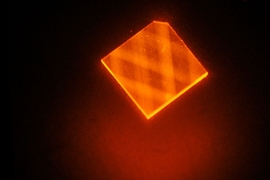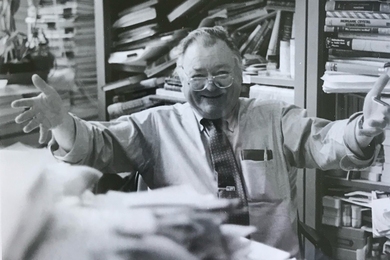On Nov. 3 at the honors banquet of the 2016 R&D 100 Conference, MIT Lincoln Laboratory accepted awards for six technologies developed either solely by laboratory researchers or collaboratively with scientists from partner organizations. Presented annually since 1962, the R&D 100 Awards recognize the 100 technology products judged by a panel of R&D Magazine editors and outside experts to be the most significant new developments of the year.
"This was a very strong year for research and development across various markets, led by many outstanding technologies that broadened the scope of innovation," said R&D Magazine editor Anna Spiewak.
"The R&D 100 Awards highlight MIT Lincoln Laboratory's strong technology development and transition role. Having so many projects recognized over the years is a great credit to everyone involved," said Eric Evans, director of Lincoln Laboratory.
Three of Lincoln Laboratory's 2016 award-winning technologies address challenges in air traffic safety:
- Airborne Collision Avoidance System for Unmanned Aircraft, a system that processes multisensor data to allow unpiloted aircraft to detect and track nearby aircraft and to enable ground operators to direct safe separation between unpiloted vehicles and other air traffic;
- Offshore Precipitation Capability, a system that provides weather information for air traffic controllers by generating "radar-like" depictions of storms in offshore regions that are outside radar coverage; and
- Small Airport Surveillance Sensor, a low-cost secondary surveillance system that provides airport tower controllers with situational awareness of aircraft on the airport surface and in nearby airspace.
Two winners offer innovative technology for improving health care:
- EnteroPhone, a wireless, ingestible device that monitors heart and breathing rates by listening to the body's sounds and that senses core temperature, all from within the gastrointestinal tract; and
- Laserscope, a tool set that offers surgical navigation and precise laser targeting within the spinal cavity to enable treatment of back pain with an outpatient procedure instead of with open back surgery.
The sixth awardee expands the functionality and efficiency of current magnetometers:
- Broadband Magnetometry and Temperature Sensing with a Light-Trapping Diamond Waveguide, an ultrasensitive magnetic-field detector and temperature sensor that is 1,000 times more energy-efficient than previous diamond-based magnetometers.
All six winners employ innovative solutions to difficult problems, may yield significant impacts on current practices, or will advance the state of the art in their fields.
Making the skies safe for unpiloted aircraft
The Airborne Collision Avoidance System for Unmanned Aircraft (ACAS Xu) is an automated collision avoidance tool for unpiloted aerial systems. The system relies on significant advances in dynamic programming, automated tuning, and parallel computing to enable unpiloted aircraft to detect and track nearby aircraft. Using the detection and tracking information, ACAS Xu provides ground operators or the vehicle’s automation with safety alerts that help them maintain separation and prevent midair collisions between unpiloted air vehicles and between piloted and unpiloted aircraft. The system is designed to coordinate maneuvers and interoperate with collision avoidance systems on all other piloted and unpiloted aircraft.
ACAS Xu receives sensor measurements from onboard surveillance systems and uses advanced tracking algorithms to estimate the relative position and velocity of nearby aircraft. These estimates are used in the threat logic to provide guidance, if necessary, to avoid a potential midair collision. ACAS Xu's modular architecture has two main components: a surveillance and tracking module (STM) and a threat resolution module (TRM). The STM takes in surveillance information (position, velocity, and altitude) from multiple sources — for example, GPS, transponders, and radar systems — to detect and track nearby aircraft. Then, the STM correlates the data from each surveillance source and passes the best-quality information to the TRM. The TRM's numeric lookup table recommends to both the unpiloted system and ground operators the optimal action, given the relative position and velocity of nearby aircraft. Typically, no action is necessary, but if nearby aircraft pose a collision risk, the TRM selects and relays the optimal advisory, suggesting a climb, descent, or turn to maintain safe separation.
"This system provides an effective solution to the demand for expanded operation of unmanned aircraft in civil airspace," said Wes Olson, a principal investigator on the ACAS Xu development team. "ACAS Xu has been demonstrated to be over 40 percent safer than the existing transponder-based collision avoidance system, and it can also detect and avoid aircraft not equipped with transponders. No other current or proposed system provides this capability," he added. ACAS Xu was developed by a team that included representatives from Lincoln Laboratory, the Federal Aviation Administration, Johns Hopkins University Applied Physics Laboratory, Stanford University, and the MITRE Corporation.
Expanding the picture of offshore weather
The Offshore Precipitation Capability (OPC), developed by the laboratory in conjunction with the Federal Aviation Administration, is a system that supplies air traffic controllers with weather information that enables them to safely reroute aircraft around storms that may cause hail, turbulence, icing, and other hazardous conditions. The OPC generates "radar-like" depictions of precipitation intensity and storm height in offshore regions where weather radar coverage is incomplete or unavailable. A supervised machine learning methodology applies advanced analytics and machine learning to fuse multiple heterogeneous datasets and create the radar-like proxy that displays weather information for shoreline areas.
OPC creates its weather "picture" by merging information from various available non-radar data sources: lightning detections, information from geostationary satellites, and outputs from numerical weather prediction models. Lightning is a strong indicator of convective weather — that is, weather capable of generating the powerful updrafts that can cause severe turbulence and other safety hazards like severe hail. Geostationary satellites positioned around the globe provide visible and infrared imagery of much of the Earth on a fairly regular basis. The numerical weather prediction models simulate many meteorological measurements, including environmental temperature, pressure, and humidity, and other relevant parameters, such as radar reflectivity, rain rate, and convective cloud-top height.
Results from the OPC data fusion are blended with outputs from existing radar-based systems to create seamless mosaics of weather systems that extend into offshore and oceanic regions. OPC applies a motion-tracking algorithm to estimate storm motion so that the features obtained from satellite imagery and numerical models can be spatially shifted to keep the mosaics up to date.
"By including high-resolution inputs, such as visible satellite imagery and lightning density, OPC is able to resolve some finer-resolution storm characteristics that are missed by systems that rely only on infrared satellite or lightning data," said Mark Veillette, a lead researcher on the development team. "The OPC framework provides users with weather analyses that are more accurate than those than those conducted with data from single-source systems."
Affordable radar surveillance for small airports
The Small Airport Surveillance Sensor (SASS) is an inexpensive surveillance system that provides airport tower controllers with situational awareness of aircraft on the airport surface and in nearby airspace under all visibility conditions, including nighttime and inclement weather. The SASS system consists of a master unit and two sensor units. The sensor units are located near the ends of the longest runway, and the master unit is located in the airport control tower. The sensor units listen for spontaneous replies from nearby aircraft equipped with Mode S beacon transponders. At least one of the sensors can also issue interrogations to aircraft with legacy transponders that do not spontaneously generate replies. Each sensor uses a novel eight-element phased array antenna to make high-accuracy azimuth measurements of the replies and uses GPS to precisely record the time of arrival of the replies.
The replies from the nearby aircraft pass to the master unit that computes the geographic location of surface and airborne targets, such as vehicles and aircraft. The target locations are passed to a fusion tracker that combines geographic location data with external information to produce tracks (smoothed geolocations indicating a predicted path of movement). Tracks can also be input to safety logic, providing visual and audible alarms to tower controllers and pilots.
Because only two sensors are needed on the airport surface, the purchase, installation, and maintenance costs of the system are affordable for small airports, which typically that lack a robust radar surveillance capability but instead rely on tower controllers to visually scan the airport surface and immediate airspace for situational awareness. "SASS will improve safety and efficiency at hundreds of small towered airports across the country," said Steven Campbell, technical lead of the Lincoln Laboratory team that developed SASS.
Listening to the body's vital signs
EnteroPhone is a tiny, wireless, ingestible device developed by Lincoln Laboratory and MIT researchers. It monitors heart and breathing rates by listening to the body's sounds, and it senses core temperature, all from within the gastrointestinal tract.
EnteroPhone's ability to reliably monitor those key vital signs gives physicians, physical therapists, and athletic trainers a tool that obviates the need for the superficial attachment of obtrusive sensors or the surgical implantation of internal sensors. Body-worn devices may aggravate injuries or cause skin irritation, for example, in burn victims, or hinder athletic performance by being uncomfortable during vigorous activity. Furthermore, no wearable sensor can collect core body temperature, a critical physiological parameter; skin temperature as collected by current external devices is a poor predictor of core temperature, particularly if a person is running a fever or engaging in physical activity. Medical devices that remain in the body until surgically removed can prevent physicians from employing certain diagnostic procedures, such as MRI; this limitation encourages device transience, which EnteroPhone offers.
Other current physiological sensors can only produce one measurement at a time and often do not measure vital signs per se. EnteroPhone — a capsule about the size of a multivitamin pill — overcomes these limitations by using a single piezoelectric hydrophone assembly to listen to heart and lung sounds to determine respiratory and heart rate. Also on board is a thermistor to measure true body core temperature, an accelerometer to measure activity, and a barometer to measure gastrointestinal (GI) pressure for a medical testing technique called manometry (currently used to evaluate how well smooth muscle along the GI tract is working). These measurements are then transmitted wirelessly from inside the body to a processor that separates background noise from the GI tract before converting the feedback to reliable, useful information about a patient's heart and breathing rates. EnteroPhone has a transmission range of approximately 20 feet.
"EnteroPhone has the capability to significantly aid telemedicine; optimize performance monitoring and safety of athletes, military service members, and first-responders; and provide an easy method for rapid clinical evaluation and triage," said Albert Swiston, the principal researcher on the EnteroPhone project.
Revolutionizing back surgery
Under development by staff at Lincoln Laboratory in collaboration with a neurosurgeon from the Massachusetts General Hospital, Laserscope will enable a surgeon to perform very precise endoscopic surgery within the spinal canal via a naturally existing access port near the base of the sacrum. This tool is being developed to treat lumbar spinal stenosis, which is a leading cause of back and leg pain and is due to the narrowing of the spinal canal from normal aging, severe trauma, or repeated spinal trauma. With Laserscope, a surgeon will be able to decompress the spinal canal in a minimally invasive outpatient procedure, providing an alternative to open back surgery.
Laserscope will enable minimally invasive access to the spinal canal, the ability to visually identify the compressive tissue, and the laser energy necessary to remove this compressive tissue. The curved 3-mm diameter Laserscope conforms to the shape of the spinal canal, allowing the surgeon to smoothly ascend the spinal canal and thereby maneuver to the compressive tissue. The device incorporates a complementary metal-oxide semiconductor (CMOS) sensor with advanced image processing to deliver a high-fidelity video visualization of the tissue to be removed. Laserscope is also designed with "petals" that, when expanded within the canal, allow the surgeon an open, clear view of the target area. Using a system of concentric nitinol tubes, Laserscope will permit the surgeon to precisely steer the laser fiber anywhere within the CMOS sensor's field of view, allowing for targeted ablation of compressive tissue with minimal damage to surrounding tissue.
"For the half-million Americans who suffer from lumbar stenosis, Laserscope will enable an approach that significantly reduces surgical costs, hospital stays, and painful rehabilitation," said Matt Johnson, principal investigator on Laserscope's development.
Enabling ultrasensitive magnetic-field detection
Broadband Magnetometry and Temperature Sensing with a Light-Trapping Diamond Waveguide, developed by scientists from Lincoln Laboratory and MIT, can measure small changes in magnetic field that permeate the universe. From permanent dipole moments of metal objects, to currents flowing in biological organs such as the brain or heart, or even to natural phenomena, such as solar flares or ocean tides, the ubiquity of the magnetic field gives details about the object itself.
To sense these subtle changes in magnetic fields, this sensor leverages an ensemble of quantum systems, called nitrogen vacancy (NV) centers, composed of a nitrogen atom paired with a missing atom in an otherwise pure carbon lattice of diamond. Each NV center has a magnetic moment whose interaction with local magnetic fields can be quantified and tied to physical constants. The minimum field detectable by the NV ensemble is enhanced by addressing a large number of NV centers, measuring the external magnetic field via probing the NV with green laser excitation and microwave radiation. The light-trapping diamond waveguide is formed by adding a prism facet to the diamond for laser excitation. Capitalizing on the high index of refraction of diamond, total internal reflection keeps light contained inside the diamond much like a multimode optical fiber. The trapped laser excitation addresses a large ensemble of NV centers, thereby enabling 1,000 times the energy efficiency in excitation and higher sensitivity in measurement.
"Our sensor has demonstrated ultrasensitive detection of magnetic fields, and it brings quantum stability to vector magnetometry. A diamond chip much smaller than a thumbnail can be engineered with trillions of nitrogen vacancies, each capable of performing its own magnetic-field measurement with diamond vector axes and quantum stability. This new class of magnetometer could lead to miniaturized devices for medical and materials imaging, contraband detection, and the study of Earth's magnetic field," said Danielle Braje, lead scientist on this research effort.
Lincoln Laboratory's R&D 100 history
Since 2010, Lincoln Laboratory has received 26 R&D 100 Awards, including two R&D 100 Editor's Choice Awards, which are given to the top three technologies from among the year's 100 selected by R&D Magazine.
In addition, Lincoln Laboratory received two earlier R&D 100 Awards: one in 1998 jointly with Cyra Technologies and the Los Alamos National Laboratory for a three-dimensional laser mapping and imaging system; the other in 1995 for a technology that determines a plane's position by using GPS.














